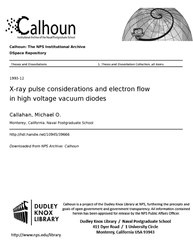File:X-ray pulse considerations and electron flow in high voltage vacuum diodes (IA xraypulseconside1094539666).pdf

Original file (1,275 × 1,650 pixels, file size: 2.46 MB, MIME type: application/pdf, 78 pages)
Captions
Captions
Summary[edit]
| X-ray pulse considerations and electron flow in high voltage vacuum diodes
( |
||
|---|---|---|
| Author |
Callahan, Michael O. |
|
| Title |
X-ray pulse considerations and electron flow in high voltage vacuum diodes |
|
| Publisher |
Monterey, California. Naval Postgraduate School |
|
| Description |
Electrical breakdown in high voltage diodes has been studied since the 1920s, yet it is still not well understood. This study characterizes the electron flow during breakdown in a high voltage vacuum diode. This was accomplished by measuring the x rays produced when electrons strike the anode of the diode. Current measurements taken during the experiment include both the displacement and conduction electron current, so the x-ray signal is the best measure of the conduction current. Knowledge of the electron flow is important in determining the mechanism of breakdown. The currently accepted explosive electron emission (EEE) model for electrical breakdown can not properly account for the energy required to form cathode spots. Schwirzke proposed a new model that involves an ionization process and a subsequent unipolar arc that accounts for the energy to form the spots. Electron flow for the two models is very different. The EEE model requires a large current density for several nanoseconds before plasma formation, whereas the new model predicts a large current density that develops simultaneously with the plasma formation. The results of thus experiment support the predictions of the new model. Subjects: Current density; Cathode spot; Vacuum diode; Unipolar arc; Space charge; X-ray |
|
| Language | English | |
| Publication date |
December 1993 publication_date QS:P577,+1993-12-00T00:00:00Z/10 |
|
| Current location |
IA Collections: navalpostgraduateschoollibrary; fedlink |
|
| Accession number |
xraypulseconside1094539666 |
|
| Source | ||
| Permission (Reusing this file) |
This publication is a work of the U.S. Government as defined in Title 17, United States Code, Section 101. As such, it is in the public domain, and under the provisions of Title 17, United States Code, Section 105, may not be copyrighted. | |
Licensing[edit]
| Public domainPublic domainfalsefalse |
This work is in the public domain in the United States because it is a work prepared by an officer or employee of the United States Government as part of that person’s official duties under the terms of Title 17, Chapter 1, Section 105 of the US Code.
Note: This only applies to original works of the Federal Government and not to the work of any individual U.S. state, territory, commonwealth, county, municipality, or any other subdivision. This template also does not apply to postage stamp designs published by the United States Postal Service since 1978. (See § 313.6(C)(1) of Compendium of U.S. Copyright Office Practices). It also does not apply to certain US coins; see The US Mint Terms of Use.
|
 | |
| This file has been identified as being free of known restrictions under copyright law, including all related and neighboring rights. | ||
https://creativecommons.org/publicdomain/mark/1.0/PDMCreative Commons Public Domain Mark 1.0falsefalse
File history
Click on a date/time to view the file as it appeared at that time.
| Date/Time | Thumbnail | Dimensions | User | Comment | |
|---|---|---|---|---|---|
| current | 02:14, 26 July 2020 |  | 1,275 × 1,650, 78 pages (2.46 MB) | Fæ (talk | contribs) | FEDLINK - United States Federal Collection xraypulseconside1094539666 (User talk:Fæ/IA books#Fork8) (batch 1993-2020 #32586) |
You cannot overwrite this file.
File usage on Commons
The following page uses this file:
Metadata
This file contains additional information such as Exif metadata which may have been added by the digital camera, scanner, or software program used to create or digitize it. If the file has been modified from its original state, some details such as the timestamp may not fully reflect those of the original file. The timestamp is only as accurate as the clock in the camera, and it may be completely wrong.
| Short title | X-ray pulse considerations and electron flow in high voltage vacuum diodes |
|---|---|
| Author | Callahan, Michael O. |
| Software used | Callahan, Michael O. |
| Conversion program | |
| Encrypted | no |
| Page size |
|
| Version of PDF format | 1.4 |

